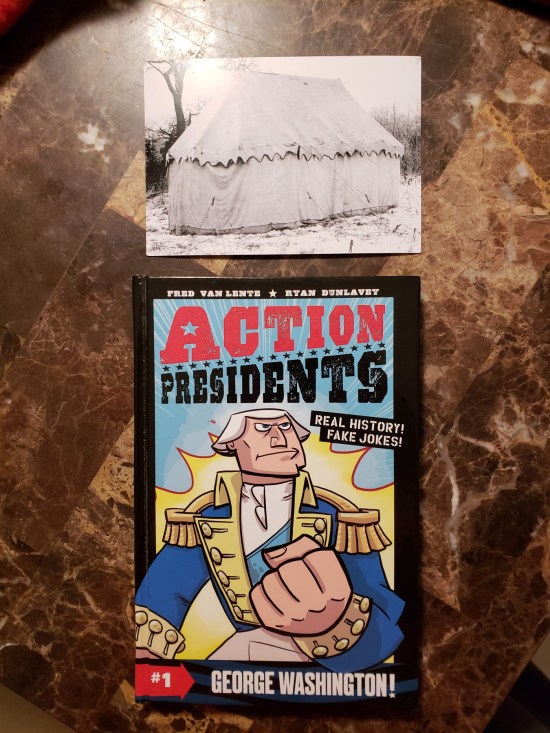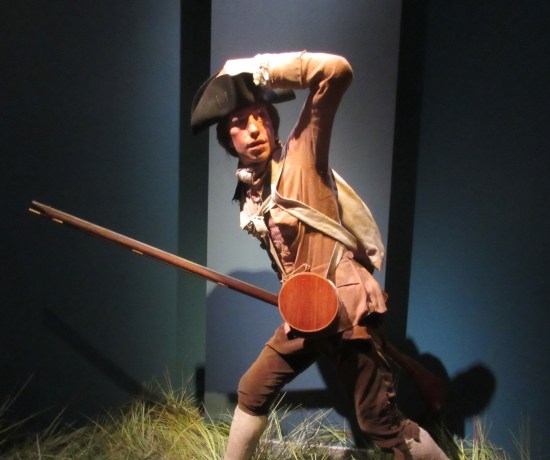
That time in December 1775 in Harvard Yard when an insult match between soldiers turned into a snowball fight, which turned into a big brawl that George Washington had to break up. That escalated quickly.
In our long, long drives through 32 states and counting, we’ve seen a version of Jamestown, Civil War battlefields, the National World War II Museum, and memorials honoring the individual casualties from America’s last 105 years’ worth of wars or so. We still have a few official war museums to cross off, which we expect will follow the pattern — lots of artifacts from the era, probably some writing samples, and of course plenty of photos where applicable.
Philadelphia’s Museum of the American Revolution features 18,000 square feet of exhibits covering the trials and tumults of our nation’s infancy, but begins with a severe disadvantage: 240 years ago, no one thought to take photos, or bothered to invent the camera in a timely manner. If a nation rises but no one Instagrammed it, is it still free?

The Museum of the American Revolution doesn’t have the square footage of the National WWII Museum, but it’s not lacking for space.
Previously on Midlife Crisis Crossover:
Every year since 1999 my wife Anne and I have taken a trip to a different part of the United States and visited attractions, wonders, and events we didn’t have back home in Indianapolis. From 1999 to 2003 we did so as best friends; from 2004 to the present, as husband and wife. Normally we’ll choose one major locale as our primary objective, drive that-a-way, and concentrate on exploring the vicinity for a few days before retreating.
We crafted this year’s itinerary with a different approach. Instead of choosing one city as a hub, we focused on one of the motifs that’s recurred through several of our trips: grave sites of Presidents of the United States of America. Our 2018 road trip would effectively have the format and feel of a video game side quest — collecting nine American Presidents across ten presidencies, four states, seven days, and 2000 miles…
Although many of its exhibits reach back to the 1700s, the museum itself has only been around since April 2017. It’s a relative babe compared to historically pedigreed neighbors such as Independence Hall or Christ Church Burial Ground. Hopefully those other establishments’ keepers are nicer to the MAR than France and Spain were to America when it was still on training wheels. Either way, the museum boasts antiques and relics we’d never seen before, a few of which once knew the touch of some of the Founding Fathers themselves.

A fireback forged in 1746 in New Jersey, bearing the coat-of-arms of King George II, who ruled England and by extension us through 1760.

An extremely rare broadside of the Declaration of Independence, printed a few days after the momentous signing.
(That very broadside originally belonged to David Rittenhouse, an astronomer, inventor, philosopher, and at one point Treasurer of Pennsylvania. Fans of NBC’s Timeless may recall one episode featured an evil version of him played by Armin Shimerman.)

Silver officers’ pistols, for higher-ranking men who prefer shorter-ranged weapons and/or carrying less weight.

A soldier’s literal portmanteau, which was a thing long before the word took on a second, linguistic fun meaning.

As with Saratoga Battlefield, its monument, and West Point, the considerable contributions of Benedict Arnold before he stabbed us collectively in the back are noted but drastically minimized. Basically he gets this placard near the ground on the far side of an unrelated booth.
The museum’s most prized possession is one of the two tents used by General George Washington himself during the war. One does not simply walk into Washington’s tent, or within twenty feet of it. The tent receives its own special presentation at select times throughout the day. Visitors may line up for timed lines, a short presentation, and the dramatic unveiling of the tent behind security glass. It’s old, it’s prestigious, it’s one of those rare accommodations about which one can actually brag, “George Washington Slept Here”.
No photos are allowed during the tent show, but the museum’s gift shop features souvenirs with preprinted professional pics for purchase and memories.

Anne got herself a Washington’s Tent postcard. I went a different direction and picked up the latest nonfiction graphic novel from Fred van Lente and Ryan Dunlavey, creators of other stellar works such as Action Philosophers! and The Comic Book History of Comics.
For lack of 18th-century paparazzi, the Museum’s primary storytelling device is creative statuary, some of which are from the same Brooklyn studio that brought us Signers’ Hall at the Constitution Center. Once again through the hands of StudioEIS, history comes alive and it’s capable of emotive expressions.

Joseph Plumb Martin was a teenage Continental Army soldier who wrote a meticulous memoir after the war. Anne read it a few weeks ago and strongly recommends it to anyone wanting to hear more in-depth about life during wartime.

An entire room is devoted to the story of the Oneida Nation and the significant assistance they gave the colonists against the British.
(As thanks for their contributions, future President Washington granted them a latitude of 6 million independent acres. Over the ages, the State of New York curtailed that to *checks notes* uh, thirty-two.)

African slaves, already subject to indignities and hardships beyond belief or basic human morality, faced hard choices regarding their roles during the war. Well, those afforded the luxury of choice.

One of the Museum’s favorite scenes: on July 9, 1776, newly declared Americans threw ropes around the bronze King George III statue in NYC’s Bowling Green, toppled it, and melted it down to make weapons and ammo. That’s one way to celebrate independence and kick off a revolution.
To be continued!
* * * * *
[Link enclosed here to handy checklist for other chapters and for our complete road trip history to date. Follow us on Facebook or via email sign-up for new-entry alerts, or over on Twitter if you want to track my TV live-tweeting and other signs of life between entries. Thanks for reading!]







